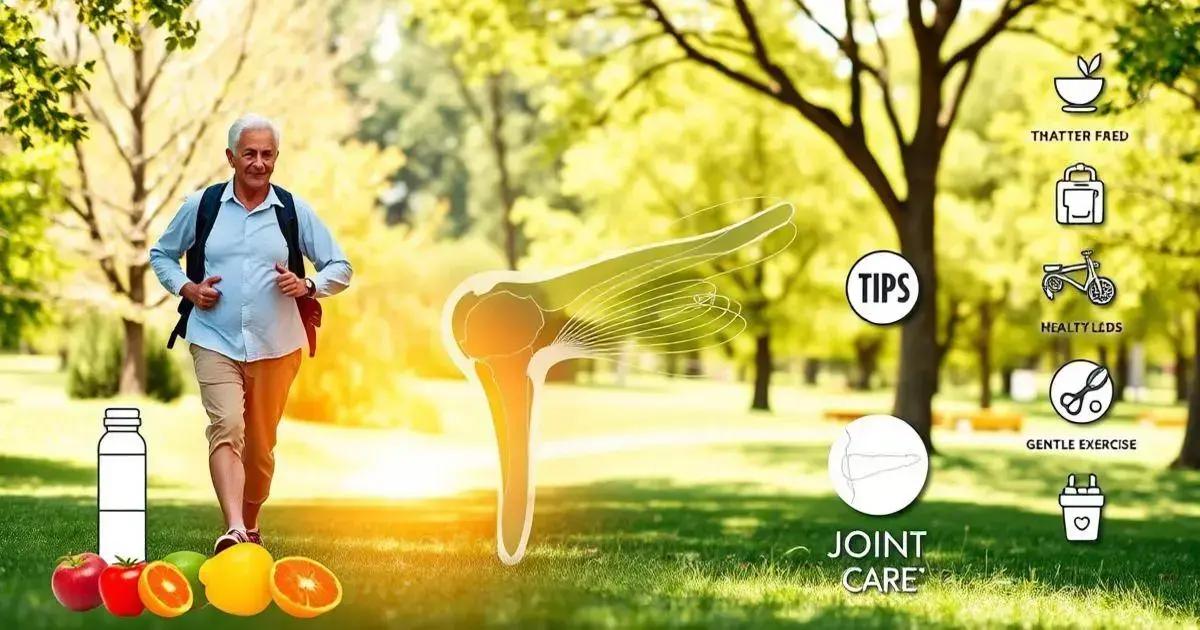Improving joint movement is crucial for an active lifestyle, offering benefits like enhanced flexibility, reduced injury risk, and better athletic performance. Engaging in range of motion exercises, stretching, and strength training can boost joint mobility, while a diet rich in omega-3 fatty acids, antioxidants, and collagen supports joint health by minimizing inflammation and aiding cartilage repair. It’s vital to seek professional help for ongoing pain, swelling, or instability to maintain optimal joint function.
Joint movement is vital for maintaining an active and healthy lifestyle. Our joints play a crucial role in how we move, and as we age, it becomes increasingly important to care for them to prevent stiffness and discomfort. By improving joint movement, you can enhance flexibility, reduce the risk of injury, and enjoy daily activities without limitations.
In this article, we will explore five key tips to help you improve your joint movement and overall mobility.
Understanding Joint Movement
Understanding joint movement is essential for maintaining overall physical health and function. Joints are the areas where two or more bones meet, allowing for a range of movements that enable us to perform daily activities like walking, bending, and lifting.
There are several types of joints in the body, each allowing for different ranges of motion:
- Ball-and-Socket Joints: These joints, such as the hips and shoulders, allow for rotational movement and a wide range of motion in multiple directions.
- Hinge Joints: Found in the elbows and knees, hinge joints allow movement in one direction, similar to the way a door opens and closes.
- Pivot Joints: These joints, like those in the neck, allow for rotational movement, enabling the head to turn side to side.
- Gliding Joints: Present in the wrists and ankles, gliding joints allow for limited movement in multiple directions, providing flexibility and stability.
Joint movement is facilitated by various components, including cartilage, ligaments, tendons, and synovial fluid. Cartilage acts as a cushion between bones, reducing friction and absorbing shock. Ligaments connect bones to other bones, providing stability, while tendons connect muscles to bones, enabling movement. Synovial fluid lubricates the joints, allowing for smooth movement.
Maintaining healthy joint movement is crucial for preventing stiffness and injuries. Factors such as age, activity level, and overall health can impact joint flexibility and mobility. Understanding how your joints function can help you take proactive steps to improve their movement and maintain an active lifestyle.

Benefits of Improved Joint Movement
Improving joint movement offers a range of benefits that contribute to overall health and well-being. Here are some key advantages of enhanced joint mobility:
- Increased Flexibility: Enhanced joint movement leads to greater flexibility, allowing for a wider range of motion in your daily activities. This can help you perform tasks more easily, whether it’s bending down to tie your shoes or reaching for something on a high shelf.
- Reduced Risk of Injury: Improved joint movement strengthens the muscles and ligaments surrounding the joints, providing better support and stability. This can significantly reduce the risk of injuries during physical activities or even simple movements.
- Enhanced Athletic Performance: For athletes and active individuals, improved joint movement can lead to better performance. Greater flexibility and range of motion can enhance strength, speed, and agility, allowing for more effective training and competition.
- Alleviation of Pain and Discomfort: Many individuals experience joint stiffness and discomfort, particularly as they age. By improving joint movement through stretching and exercise, you can alleviate pain and stiffness, making it easier to engage in everyday activities.
- Better Posture and Balance: Improved joint movement contributes to better posture and balance, as flexible joints allow for more natural body alignment. This can reduce the risk of falls and enhance overall stability.
- Enhanced Quality of Life: Overall, better joint movement leads to a higher quality of life. With improved mobility, you can participate more fully in activities you enjoy, maintain independence, and enhance your emotional well-being.
Incorporating exercises and activities that promote joint movement into your routine can help you reap these benefits, leading to a healthier and more active lifestyle.
Exercises for Better Joint Mobility
Engaging in regular exercises for better joint mobility is crucial for maintaining flexibility and reducing stiffness. Here are some effective exercises that can help improve joint movement:
- Range of Motion Exercises: These exercises involve moving your joints through their full range of motion. Simple movements like arm circles, leg swings, and wrist rotations can enhance flexibility and reduce stiffness.
- Stretching: Incorporating stretching into your routine can significantly improve joint mobility. Focus on dynamic stretches before activities and static stretches after workouts. Key stretches include hamstring stretches, quadriceps stretches, and shoulder stretches.
- Strength Training: Strengthening the muscles around your joints provides better support and stability. Incorporate exercises like squats, lunges, and resistance band exercises to build strength and enhance joint function.
- Low-Impact Aerobics: Activities such as swimming, cycling, and walking are excellent for improving joint mobility without putting excessive strain on the joints. These low-impact exercises promote cardiovascular health while keeping your joints flexible.
- Pilates and Yoga: Both Pilates and yoga emphasize flexibility, balance, and core strength. These practices can help improve joint mobility through controlled movements and stretching, promoting overall body awareness and coordination.
- Foam Rolling: Using a foam roller can help release muscle tightness and improve circulation around your joints. Focus on rolling out major muscle groups, such as the thighs, calves, and back, to enhance mobility and reduce tension.
When performing these exercises, it’s important to listen to your body and avoid pushing through pain. Start slowly, gradually increasing intensity and duration as your joint mobility improves. Always consider consulting with a healthcare professional or physical therapist before starting a new exercise program, especially if you have existing joint issues or concerns.

Nutrition for Joint Health
Nutrition plays a vital role in maintaining joint health and supporting optimal joint movement. Incorporating specific nutrients into your diet can help reduce inflammation, promote cartilage repair, and enhance overall joint function. Here are some key nutritional elements to consider:
- Omega-3 Fatty Acids: Found in fatty fish like salmon, mackerel, and sardines, omega-3s have anti-inflammatory properties that can help reduce joint pain and stiffness. Plant-based sources include flaxseeds, chia seeds, and walnuts.
- Antioxidants: Vitamins C and E, as well as other antioxidants, help combat oxidative stress, which can contribute to joint degeneration. Incorporate colorful fruits and vegetables, such as berries, citrus fruits, spinach, and bell peppers, to boost your antioxidant intake.
- Vitamin D: Essential for calcium absorption and bone health, vitamin D is crucial for maintaining strong joints. Sun exposure is a natural source, but you can also find it in fortified foods, fatty fish, and egg yolks.
- Calcium: This mineral is vital for bone health, and a deficiency can lead to weakened joints. Dairy products, leafy greens, almonds, and fortified plant-based milk are great sources of calcium.
- Collagen: As a key protein in cartilage, collagen supplementation can help support joint health. Bone broth, chicken skin, and collagen peptides are excellent sources to include in your diet.
- Turmeric: This spice contains curcumin, a compound known for its anti-inflammatory properties. Adding turmeric to your meals or taking it as a supplement can help reduce joint inflammation and pain.
- Hydration: Staying well-hydrated is essential for joint health, as it helps maintain the viscosity of synovial fluid, which lubricates the joints. Aim to drink plenty of water throughout the day.
By focusing on a balanced diet rich in these nutrients, you can support your joint health and improve overall mobility. Remember that a holistic approach, combining nutrition with regular exercise and healthy lifestyle choices, is key to maintaining optimal joint function.
When to Seek Professional Help
Knowing when to seek professional help for joint issues is essential for preventing further complications and ensuring proper care. Here are some signs and situations that warrant consulting a healthcare professional:
- Persistent Pain: If you experience ongoing joint pain that does not improve with rest, ice, or over-the-counter medications, it may be time to consult a doctor or physical therapist.
- Swelling and Inflammation: Noticeable swelling, redness, or warmth around a joint can indicate an underlying issue, such as an injury or arthritis. Seeking professional help can provide clarity and appropriate treatment options.
- Decreased Range of Motion: If you find it increasingly difficult to move your joints or perform daily activities, this may be a sign of joint dysfunction. A healthcare provider can assess your condition and recommend exercises or treatments to improve mobility.
- Joint Instability: If you experience a feeling of instability or your joint gives way during movement, it’s crucial to seek professional advice. This can help prevent further injury and determine the appropriate course of action.
- Acute Injury: If you suffer a sudden injury, such as a fall or sports-related trauma, consult a healthcare provider immediately. Early intervention can help prevent complications and ensure proper healing.
- Changes in Joint Appearance: Any significant changes in the appearance of your joints, such as deformities or abnormal growths, should be evaluated by a professional to identify potential issues.
- Consulting for Chronic Conditions: If you have a history of joint-related conditions, such as arthritis or gout, regular check-ups with a healthcare professional can help manage symptoms and prevent flare-ups.
By recognizing these signs and seeking professional help when necessary, you can ensure that your joint health is effectively managed and that you maintain optimal mobility and function.
Conclusion
In summary, maintaining healthy joint movement is crucial for an active and fulfilling lifestyle.
Understanding joint movement, enhancing flexibility through targeted exercises, and ensuring proper nutrition can significantly improve your overall joint health.
By adopting these strategies, you can reduce the risk of injury, alleviate pain, and enhance your mobility.
Recognizing when to seek professional help is equally important, as timely intervention can prevent complications and ensure effective treatment.
Remember, a holistic approach that combines exercise, nutrition, and medical support will lead to optimal joint function and a better quality of life.
Prioritize your joint health today and embrace a more active, pain-free tomorrow!
FAQ – Frequently Asked Questions about Joint Movement
What is joint movement?
Joint movement refers to the ability of joints to move and function properly, allowing for various physical activities.
What exercises can improve joint movement?
Exercises such as range of motion activities, stretching, strength training, and low-impact aerobics can enhance joint mobility.
How does nutrition affect joint health?
Nutrition plays a crucial role in joint health by providing essential nutrients that reduce inflammation and support cartilage repair.
When should I seek professional help for joint issues?
Seek professional help if you experience persistent pain, swelling, decreased range of motion, instability, or after an acute injury.
What are the benefits of improved joint movement?
Improved joint movement leads to increased flexibility, reduced injury risk, enhanced athletic performance, and better overall quality of life.
Can I manage joint health on my own?
While self-care strategies like exercise and nutrition are important, consulting a healthcare professional is advisable for persistent issues.


